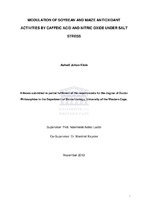| dc.description.abstract | This study explores the roles of exogenously applied nitric oxide, exogenously applied caffeic acid and salt stress on the ontioxidant system in cereal (exemplified by maize) and legume (using soybean as an example) plants together with their
influence on membrane integrity and cell death. This study investigates changes in H₂O₂ content, root lipid peroxidation, root cell death and antioxidant enzymatic activity in maize roots in response to exogenously applied nitric oxide (NO) and salt stress. This part of the study is based on the partially understood interaction between NO and reactive oxygen species (ROS) such as H₂O₂ and the role of antioxidant enzymes in plant salt stress responses. The results show that application of salt (NaCl) results in elevated levels of H₂O₂ and an increase in lipid peroxidation, consequently leading to increased cell death. The study also shows that by regulating the production and detoxification of ROS through modulation of antioxidant enzymatic activities, NO plays a pivotal role in maize responses to salt stress. The study argues for NO as a regulator of redox homeostasis that prevents excessive ROS accumulation during exposure of maize to salinity stress that would otherwise be deleterious to maize. This study extends the role of exogenously applied NO to improve salt stress tolerance in cereals crops (maize) further to its role in enhancing salt stress tolerance in legumes. The effect of long-term exposure of soybean to NO and salt stress on root nodule antioxidant activity was investigated to demonstrate the role of NO in salt stress tolerance. The results show that ROS scavenging antioxidative enzymes like SOD, GPX and GR are differentially regulated in response to exogenous application of NO and salt stress. It remains to be determined if the NO induced changes in antioxidant enzyme activity under salt stress are sufficient to efficiently reduce ROS accumulation in soybean root nodules to levels close to those of unstressed soybean root nodules.
Furthermore, this study investigates the effect of long-term exposure of soybean to exogenous caffeic acid (CA) and salt stress, on the basis of the established role of CA as an antioxidant and the involvement of antioxidant enzymes in plant salt stress responses. The effect of CA on soybean nodule number, biomass (determined on the basis of nodule dry weight, root dry weight and shoot dry weight), nodule NO content, and nodule cyclic guanosine monophosphate (cGMP) content in response to salt stress was investigated. Additionally, CA-induced changes in nodule ROS content, cell viability, lipid peroxidation and antioxidant enzyme activity as well as some genes that encode antioxidant enzymes were investigated in the presence or absence of salt stress. The study shows that long-term exposure of soybean to salt stress results in reduced biomass associated with accumulation of ROS, elevated levels of lipid peroxidation and elevated levels of cell death. However, exogenously applied CA reversed the negative effects of salt stress on soybean biomass, lipid peroxidation and cell death. CA reduced the salt stress-induced accumulation of ROS by mediating changes in root nodule antioxidant enzyme activity and gene expression. These CA-responsive antioxidant enzymes were found to be superoxide dismutase (SOD), ascorbate peroxidase (APX), glutathione peroxidase (GPX), and glutathione reductase (GR), which contributed to the scavenging of ROS in soybean nodules under salt stress. The work reported in Chapter 2 has been published in a peer-reviewed journal [Keyster M, Klein A, Ludidi N (2012) Caspase-like enzymatic activity and the
ascorbate-glutathione cycle participate in salt stress tolerance of maize conferred by exogenously applied nitric oxide. Plant Signaling and Behavior 7: 349-360]. My contribution to the published paper was all the work that is presented in Chapter 2,
whereas the rest of the work in the paper (which is not included in Chapter 2) was contributed by Dr Marshall Keyster. | en_US |

